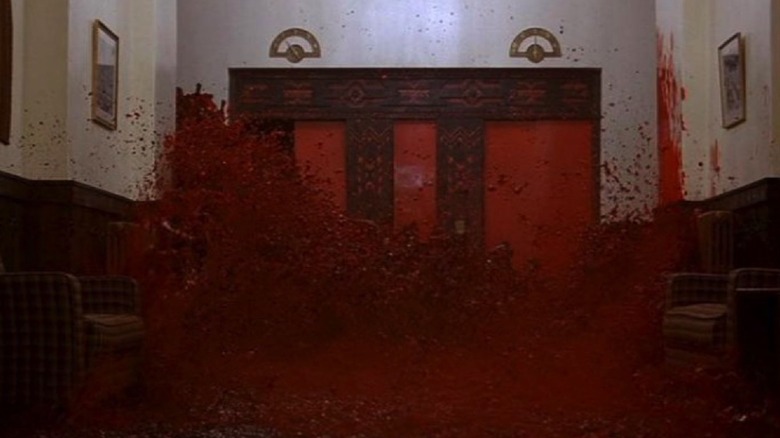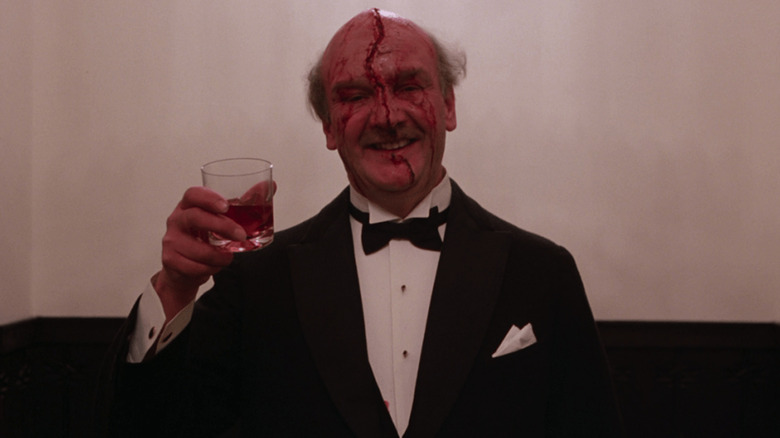How Stanley Kubrick Pulled Off The Shining's Brilliant Elevator Scene
As we approach the end of the year, many of us are indulging in Christmas-themed films. Not a lot of people think of Stanley Kubrick's 1980 horror film "The Shining" as a holiday movie (and if they do, they definitely don't consider it a happy one), but this cinematic treasure contains a visual feast of disturbing imagery that climaxes during the winter, so let's add it to the list of alternative holiday films. While many complain about the film's deviation from the Stephen King novel on which it's based, pretty much everyone can agree that the imagery used in Kubrick's film is burned into our minds. From the creepy Grady twins luring Danny Torrance to come play, the rotting old woman in the bathroom, and the ax-stricken gash in the door with Jack Nicholson's crazed face screaming "Heeeeere's Johnny!", there are plenty of scenes that still terrify moviegoers to this day. Containing multiple scenes of symbolic red, green, and white color schemes that happen to be associated with Christmas, "The Shining" is arguably a perfect horror film to watch at the moment. It's almost too perfect, given how long some of us have been in quarantine. However, one famous blood-soaked scene was particularly difficult to execute and utilized more blood than people even thought possible for the time.
In a recent interview with Yahoo, Kubrick's longtime assistant, Leon Vitali, revealed how the team was able to perfectly spill gallons of blood through the cracks of The Overlook's vintage elevator doors, causing it to gush into the hallway and head straight towards the camera. According to Vitali, Kubrick couldn't bring himself to watch the execution because of all the laborious preparation that went into its set-up. "We spent weeks and weeks and weeks trying to get the quality and color of the blood as natural as it could be," said Vitali. "You didn't want it too red. The consistency was also quite important, because we were pouring out hundreds of gallons of the stuff. And then, of course, there were the mechanics of it, because if you have that much pressure inside something like an elevator, it's going to blow if you're not careful." Any horror fan will know that the consistency and color of fake blood is extremely important, so it's not too surprising that it took such a long time to nail it down perfectly here.
There Will Be Blood
In King's 1977 novel, the elevators of The Overlook Hotel only contain ghostly remnants from a New Year's Eve party, like scattered confetti and streamers. In an attempt to bring life to a structure that houses so much death, Kubrick leaned into more dramatic angles. According to Vitali, "All of that blood pouring out of the elevator told a little bit about the hotel becoming a character itself in a way." Since special effects technology was limited at the time, the crew had to get this shot on the first take which obviously generated an immense amount of stress. On the day of shooting, the crew topped off the elevator compartment and then set up four cameras to capture the blood bath. Each camera was equipped with a different lens and different film speed. The camera operators climbed inside oversize wooden chests to avoid being doused in the red concoction. Time was of the essence because the elevator could not withstand the liquid for very long. In fact, Vitali recalled, "the elevator was starting to leak before the doors actually opened." If you look closely in the film, you can see small amounts starting to seep through. Even though this is a mild slip-up, it still plays into the film's dramatic progression of evil coming forth as sanity slowly slips away from the Torrance family.
After calling "action," Kubrick anxiously left the set as the rest of the crew watched as the blood mixture pouring out of the doors and flooding the hallway, covering everything in its path. Here's Vitali again:
"I tell you, it worked in a way we never thought it would work. That deluge of blood was picking up things like the sofas. It was such a violent volume of this red liquid coming at you; those of us who were in there thought, 'My God — we're doing to drown!' When Stanley saw the footage, he was so happy."
Kubrick is known for his meticulous shots, striking cinematography, and elaborate set designs, and "The Shining" is a prime example of his supreme talent. In the CGI era, watching special effects scenes like this can sometimes feel as if you're witnessing a disappearing art form. But like the ghosts of The Overlook, this film is so captivating and perfectly executed that it bewitches audiences to visit its haunted halls forever ... and ever ... and ever.

